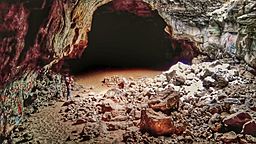Pluto's Cave facts for kids
Quick facts for kids Pluto's Cave |
|
|---|---|

Entrance to the cave
|
|
| Location | Siskiyou County, California, United States |
| Length | 0.5 to 1 mile (0.80 to 1.61 km) |
| Discovery | 1863 |
| Geology | Lava tube |
Pluto's Cave (also called Pluto Cave) is a long, empty tunnel formed by ancient lava. It is located near Mount Shasta in California. This amazing cave is a type of lava tube. It formed when hot, flowing lava cooled on the outside, creating a hard crust. But the lava inside kept flowing, leaving behind a hollow tube.
Pluto's Cave is about 190,000 years old. That's very old for a lava tube! Most lava tubes collapse much faster because their roofs are only a few feet thick. However, Pluto's Cave is in a dry area. This means there isn't much erosion (wearing away by wind or water), which has helped the cave survive for so long.
Contents
Discovering Pluto's Cave
The cave was first found in the spring of 1863. A man named Nelson Cash discovered it while he was looking for his lost cattle. In April 1863, the cave was explored more deeply. It was named "Pluto's Cave" after Pluto, who was the Greek god of the underworld.
Early Explorers of the Cave
Many important explorers and scientists visited Pluto's Cave in the 1800s. They were fascinated by its unique formation and features.
William Henry Brewer's Visit
William Henry Brewer, a scientist working for the California Division of Mines and Geology, visited the cave on October 10, 1863. He wrote about his experience, describing the cave as a "curiosity."
Brewer noted that the cave was under a rocky lava slope. He thought it looked like a giant stream of melted lava had flowed out, leaving an empty channel. The roof of the cave was beautifully arched, reaching up to 50 feet high and 50 feet wide in some places. The floor was made of broken lava rocks. He saw many bats living deep inside the cave. Near the entrance, the roof had fallen in, and he found skulls of mountain sheep that had gotten trapped.
Clarence King's Return
In 1870, Clarence King, another explorer who had visited with Brewer, returned to Pluto's Cave. He described entering the cave through a round hole. The entrance was a large archway of black lava, about 60 feet wide and 80 feet high.
King and his companion followed the cave, which was a fairly regular tube, for about half to three-quarters of a mile. They noticed smooth, bubbly shapes on the cave walls, formed by the cooling lava. Bats and owls flew silently past their candles. At the end of the cave, they sat on piles of rocks. They even blew out their candle to experience the complete darkness, then fired a pistol to hear its muffled sound. King explained that the cave formed when the surface of a lava flow cooled, but the molten lava inside burst out at the lower end, leaving an empty tube.
John Muir's Observations
The famous naturalist John Muir explored the Mount Shasta area in 1874–75. He included Pluto's Cave in his guide for exploring the mountain. Muir mentioned that the cave is not easy to find because its entrances are flat with the ground. These entrances were created when parts of the cave's roof collapsed. He encouraged people to explore these "dark ways of the underworld" to better appreciate the beauty of sunshine when they returned.
Cave Use and Visiting
Evidence has been found that Pre-Columbian peoples used Pluto's Cave long ago. Today, visitors can safely hike into the cave for about 1,200 feet (366 meters). It's a great place to explore a natural wonder formed by ancient volcanoes!
Images for kids


